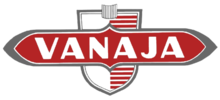 | |
| Company type | Osakeyhtiö |
|---|---|
| Industry | Automotive |
| Predecessor | Yhteissisu Oy |
| Founded | 20 March 1943[1] |
| Defunct | 31 December 1968[2] |
| Fate | Merged with Oy Suomen Autoteollisuus Ab |
| Successor | Patria Land and Armament; Sisu Axles |
| Headquarters | , |
| Products | Lorries, bus chassis, special vehicles |
| Owner | State of Finland A. Ahlström Oy Ata Oy Oy Fiskars Ab Kone Osakeyhtiö Kymin Osakeyhtiö Lokomo Oy Oy Strömberg Ab Oy Suomen Autoteollisuus Ab Suomen Gummitehdas Oy Suomen Kaapelitehdas Oy Tampereen Pellava- ja Rautateollisuus Oy W. Rosenlew & Co. Oy Yhtyneet Paperitehtaat Oy[1] |
Number of employees | 400 (early 1968) |
Vanajan Autotehdas Oy (VAT) was a producer of heavy vehicles based in Hämeenlinna, Finland. The company was founded as Yhteissisu Oy in 1943 by the Finnish government and a number of major Finnish companies with the aim of producing lorries and buses for the Finnish Defence Forces. World War II was over before the company could start series production; it was renamed Vanajan Autotehdas and the marque became Vanaja. Subsequently, the production consisted of outdated lorry models, partly built from military surplus materials. After overcoming initial difficulties, the company modernised its products, became profitable and grew until the mid-1950s. Many major components, including engines, were imported. Diesel engines became widely available in 1955, and in 1959 VAT introduced its most significant innovation, the full load lifting tandem axle mechanism, which improved off-road capability significantly; the system is now used in Sisu vehicles.
The company started producing bus chassis in 1950, and the superstructures were built by a number of Finnish coach builders. The last models were appreciated by a number of bus operators, and missed after production was stopped. All Vanaja bus chassis were fitted with air brakes by 1958, after the failure of hydraulic brakes on a Vanaja bus had led to one of the worst traffic accidents ever to have happened in Finland.
VAT fell into financial difficulties by end of the 1960s; this led to a merger with the other Finnish heavy vehicle producer Oy Suomen Autoteollisuus Ab at the end of 1968. The Vanaja brand ceased to exist in 1971, after which the former Vanaja factory produced Sisu terminal tractors, bus chassis, military vehicles and mobile crane chassis. The factory now belongs to Patria—which produces Patria AMV armoured personnel carriers—and heavy-vehicle axle producer Sisu Axles.
Vanajan Autotehdas was always a small company, employing about 400 people in 1968, and in the 1960s its market share was barely 5% in Finland. Almost all Vanajas were sold for the domestic market; only a few units were exported. Vanaja vehicles became known for their robust construction and high degree of customisation. The number of Vanaja bus chassis and lorries totalled 7,140 units; this consists of 260 lorry and 66 bus chassis models; for 116 lorry models only one or two units were produced. Vanajas had a good reputation and they are nowadays valued by vintage vehicle enthusiasts.